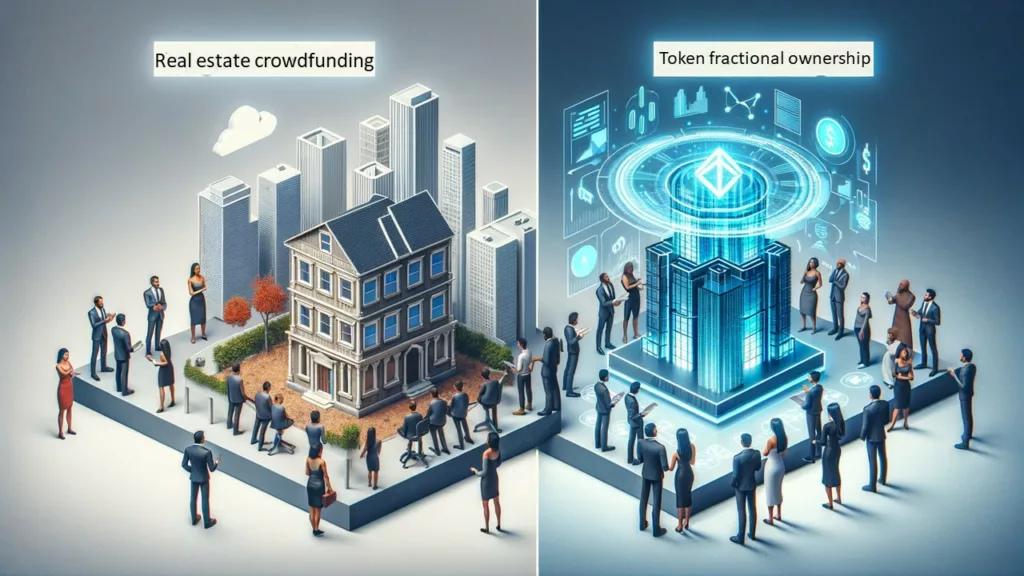In the dynamic world of real estate investment, two innovative models have gained significant traction: real estate crowdfunding and tokenized fractional ownership. Both offer exciting opportunities for small-time investors looking to dip their toes into the real estate market. In this article, we’ll conduct a comprehensive comparison of these two emerging investment models to help investors understand the differences, benefits, and potential drawbacks of each approach.
Real Estate Crowdfunding:
Real estate crowdfunding allows multiple investors to pool their funds to collectively invest in a real estate project. Here’s a closer look at this investment model:
1. Accessible Entry:
- Crowdfunding platforms open doors to real estate investments for a broader audience. Small-time investors can participate with relatively modest capital, making it more accessible.
2. Diverse Investment Options:
- Crowdfunding platform offer a range of projects across various property types. Investors can choose projects that align with their preferences, risk tolerance, and investment goals.
3. Passive Investment:
- Investors in real estate crowdfunding typically play a passive role. They provide funds and share in the profits, but the day-to-day management of the property is typically handled by professionals.
4. Limited Liquidity:
- Real estate crowdfunding investments often have limited liquidity. Investors may be locked into their investments for the duration of the project, which can span several years.

Tokenized Fractional Ownership:
Tokenized fractional ownership, on the other hand, leverages blockchain technology to divide ownership of real estate into digital tokens. Here’s an overview of this investment model:
1. Enhanced Liquidity:
- Tokenized fractional ownership provides greater liquidity compared to crowdfunding. Investors can buy and sell tokens on digital platforms, offering more flexibility and potential for quicker access to funds.
2. Transparent Ownership Records:
- Blockchain technology ensures transparent and immutable ownership records. Investors can easily verify their ownership and the history of their tokens, reducing the risk of disputes.
3. Diversification Control:
- Tokenization allows investors to have more control over diversification. They can select specific properties or projects in which to invest, tailoring their portfolios to their preferences.
4. Regulatory Considerations:
- Tokenized fractional ownership is subject to evolving regulations. Investors should stay informed about the legal requirements in their region to ensure compliance.

Comparison and Analysis: crowdfunding vs tokenized fractional ownership
1. Liquidity:
- Tokenized fractional ownership offers superior liquidity. Investors can buy and sell tokens on digital platforms, whereas crowdfunding investments often have limited liquidity due to project lock-in periods.
2. Accessibility:
- Both models aim to make real estate accessible to small-time investors, but crowdfunding may require less technical knowledge as it doesn’t involve blockchain technology.
3. Diversification:
- While both models offer diversification opportunities, tokenization provides more control over property selection. Crowdfunding platforms offer a range of projects, but investors have less say in individual property choices.
4. Transparency:
- Blockchain technology enhances transparency in tokenized fractional ownership, providing a clear and immutable record of ownership. Crowdfunding platforms also provide transparency but through traditional systems.
5. Passive vs. Active Involvement:
- Crowdfunding typically involves passive investment, with project management handled by professionals. Tokenized fractional ownership may require more active involvement in property selection and management decisions.
6. Regulatory Environment:
- Both models are subject to evolving regulatory considerations. It’s important for investors to stay updated on legal requirements in their jurisdiction.

Conclusion:
The choice between real estate crowdfunding and tokenized fractional ownership ultimately depends on individual preferences, risk tolerance, and investment goals. Crowdfunding offers accessible entry and passive involvement, while tokenization provides enhanced liquidity, transparency, and diversification control.
When it comes to real estate crowdfunding vs tokenized fractional ownership, both are valuable additions to the real estate investment landscape, catering to small-time investors looking to diversify their portfolios and participate in the dynamic world of real estate. Understanding the differences between these two models can help investors choose the approach that best suits their needs.
Disclaimer: Before making any investment decisions, it’s advisable to conduct thorough research, seek professional advice when necessary, and align your investments with your financial goals.
Finally, we refined and enhanced the article using ChatGPT.

